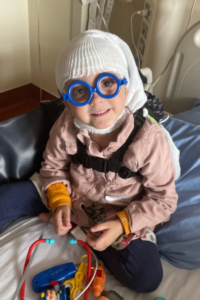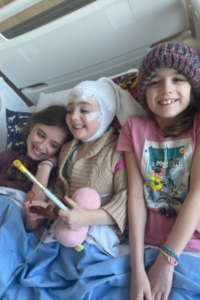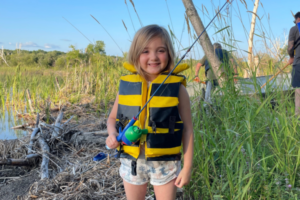Adelaide’s HH Journey
Adelaide was born on November 23, 2018 as the youngest sibling to her two sisters and brother. She met all of her milestones however she was very hard to settle, didn’t sleep very well (even for a baby) and cried quite a bit. For the first 18 months of her life she needed to be held or worn most of the time in an attempt to comfort and co-regulate. When she was feeling well she was engaging, interested in everything around her, had a sense of humor and loved being with her family.
In September 2019, when Adelaide was about 9 months old, we started noticing some differences in her growth. With the help of other family members, we noticed Adelaide was having some breast development and body hair growth. We took her to our family doctor who was very concerned and sent us straight to a pediatrician. The pediatrician immediately sent us to endocrinology for a consultation and testing. After some blood work and a bone density scan, it was determined that Adelaide had precocious puberty and her bones were a year older than her chronological age. There were many theories for this but the main one was a tumor on her pituitary gland. We were terrified and waited for an MRI date to confirm what was going on.
In October 2019, it was determined that Adelaide had a rare benign tumor called hypothalamic hamartoma. This tumor is attached to her hypothalamus and pressing on her pituitary gland. We learned this type of tumor can cause many complications, but the two main ones are precocious puberty and epilepsy. The doctors explained at the time that individuals with HH usually develop one or the other and most likely Adelaide would not develop epilepsy as she had been diagnosed with precocious puberty.
 Adelaide was put on Lupron injections to suppress her hormones and treat the precocious puberty. This is a painful needle every 8 weeks until she is old enough to start puberty naturally, around 9 years old. If this is not done, she would complete puberty before the age of 2 and be a fully developed adult but the size of a 2 or 3 year old for the rest of her life. We are thankful this treatment is covered but it is hard for her to go to the hospital every eight weeks for this treatment. Her nurse and the child life therapists are amazing.
Adelaide was put on Lupron injections to suppress her hormones and treat the precocious puberty. This is a painful needle every 8 weeks until she is old enough to start puberty naturally, around 9 years old. If this is not done, she would complete puberty before the age of 2 and be a fully developed adult but the size of a 2 or 3 year old for the rest of her life. We are thankful this treatment is covered but it is hard for her to go to the hospital every eight weeks for this treatment. Her nurse and the child life therapists are amazing.
We monitored her and in January 2020 a short EEG was done on Adelaide with no signs of seizures. As the year went on we noticed a couple of episodes which appeared to be seizure activity. These included some blank stares and one laughing episode. Gelastic seizures (laughing seizures) are the signature seizure when affected by Hypothalamic Hamartoma Syndrome. Adelaide’s gelastic seizures looks like laughing. There are also crying seizures that can be closely related that are called dacrystic seizures. Adelaide also had many crying episodes at night.
On May 12, 2020 we spent a few nights in the hospital to get a longer EEG, but no seizure activity was detected on the EEG. We learned gelastic and dacrystic seizures happen so deep in the brain that they are nearly impossible to detect on an EEG. Although the seizures were happening frequently there was no way to know besides visual indicators and behaviors.
Over the next several months, we had many appointments and meetings and were connected to the team in Calgary at Alberta Children’s hospital. In October 2021, we met with Dr. Julia Jacobs-Levan, a pediatric neurologist who specializes in Hypothalamic Hamartoma Syndrome and as well as the neurosurgeon, Dr. Hader. They explained that although we cannot see the seizures on the EEG they are happening and if they are allowed to continue they will develop into other seizure types and most likely cause cognitive decline. By this point we had tried some anti-epileptic medications and found they did not work on the gelastic seizures, as there are currently no medications available for these types of seizures.
It was decided that Adelaide would have brain surgery in Calgary. The recommendation was to have a laser interstitial thermal therapy (LITT) procedure. This procedure uses a small laser to destroy unhealthy brain tissue. The plan was to drill a hole through the skull into the brain and the neurosurgeon would use the laser to sever the stalk that connects the hypothalamic hamartoma to her hypothalamus.
A pre-operative MRI was needed to plan the surgery and a psychological evaluation to determine Adelaide’s baseline.
 The surgery took place on December 8, 2021 at Foothills Medical Centre (FMC) in Calgary. It took 7 hours before we were able to see Adelaide. The wait was excruciating, but she did so well through surgery. After surgery we were taken by ambulance to the Alberta Children’s Hospital ICU, where we stayed until Adelaide’s release on December 13th. The surgery went well and it appeared her seizures were gone. There were some complications from the surgery though which were some facial drooping. The other symptom we noticed in the hospital, but more so when we got home; Adelaide had no short-term memory. She would eat a snack and then ask for a snack 5 minutes later. Or have a bath and forget that she had just had one and want another one. This was very hard to navigate because she was rarely settled and very agitated. Her seizures were gone but her memory was also gone. We took it day by day and her memory improved. Unfortunately, in February of 2022 Adelaide started having gelastic seizures again.
The surgery took place on December 8, 2021 at Foothills Medical Centre (FMC) in Calgary. It took 7 hours before we were able to see Adelaide. The wait was excruciating, but she did so well through surgery. After surgery we were taken by ambulance to the Alberta Children’s Hospital ICU, where we stayed until Adelaide’s release on December 13th. The surgery went well and it appeared her seizures were gone. There were some complications from the surgery though which were some facial drooping. The other symptom we noticed in the hospital, but more so when we got home; Adelaide had no short-term memory. She would eat a snack and then ask for a snack 5 minutes later. Or have a bath and forget that she had just had one and want another one. This was very hard to navigate because she was rarely settled and very agitated. Her seizures were gone but her memory was also gone. We took it day by day and her memory improved. Unfortunately, in February of 2022 Adelaide started having gelastic seizures again.
In April of 2022, we did another EEG at JCPH that gave us no answers. In May 2022, we went back to Calgary for another MRI, and an EEG. We were told that another LITT procedure was needed and the approach this time would include blasting the actual tumor. We were warned this could be a bit more invasive but hopefully this would do the trick and resolve the gelastic seizure. Her second surgery was on July 6th 2022. Another 7 hour wait and we were able see our sweet girl again. She did really well during the surgery. Unfortunately, the next day she had a seizure. We were absolutely devastated. The team tried to calm us and explain that sometimes the brain needs to heal after surgery and to wait to see if the seizures subsided. So we went home to monitor. Unfortunately, the summer was awful as her seizures were increasing up to 100 a day. Along with the seizures she was struggling with hypothalamic rages which are common with Hypothalamic Hamartoma Syndrome.
In September 2022 Adelaide’s case was presented at the 4th International Hypothalamic Hamartoma Symposium and the consensus from the medical team in attendance was that the anecdotal evidence suggests seizures can increase before they get better. So again we waited and monitored. To our relief the seizures settled a bit by Christmas. Adelaide continued to have other concerning symptoms such as low energy to the point of needing a nap every afternoon and then being too tired to eat supper.
In February of 2023 Adelaide’s seizures increased again. We had another long EEG but again nothing showed up. She was now able to tell us when she had a seizure and was also self conscious of having them in public. After a seizure she becomes tired and it affects her ability to play and learn.
After many meetings and appointments it was determined that Adelaide would have a third surgery to sever the rest of the stalk connecting the tumor to the brain.
 On June 6th 2023 Adelaide had her third brain surgery. Once again life felt surreal as we handed her over to the surgical team and left our baby for over 6 hours. We were told that memory loss/ damage to short term memory, hypothalamic obesity and diabetes incipidus were the risks. Thankfully Adelaide’s surgery went very well. According to the MRI it looked as though the hamartoma was now detached on all sides. There were some ups and downs in the ICU but overall she did so well and we made it to the neurology bed the next day. Unfortunately the next day, Adelaide had a gelastic seizure. We were beyond devastated. The physical and emotional letdown of having to entertain the idea that her third surgery didn’t work, was unexplainable. We were told to keep positive as the brain still had healing to do. Thankfully Adelaide had no complications from her third surgery and we were on our way home a few days later.
On June 6th 2023 Adelaide had her third brain surgery. Once again life felt surreal as we handed her over to the surgical team and left our baby for over 6 hours. We were told that memory loss/ damage to short term memory, hypothalamic obesity and diabetes incipidus were the risks. Thankfully Adelaide’s surgery went very well. According to the MRI it looked as though the hamartoma was now detached on all sides. There were some ups and downs in the ICU but overall she did so well and we made it to the neurology bed the next day. Unfortunately the next day, Adelaide had a gelastic seizure. We were beyond devastated. The physical and emotional letdown of having to entertain the idea that her third surgery didn’t work, was unexplainable. We were told to keep positive as the brain still had healing to do. Thankfully Adelaide had no complications from her third surgery and we were on our way home a few days later.
Since her surgery the journey has continued. At first Adelaide only had a couple seizures a day. Now she is up to at least 7 gelastic seizures a day as well as what she calls quiet seizures and shiver seizures. It appears they are increasing in frequency once again. The latest call with the surgeon explained that he needs to see an MRI of her brain in order to know what is truly going on, however, his theory is that there are too many abnormal cells from the hamartoma mingling into her hypothalamus. If most of the lesion (hamartoma) is gone when he looks at the MRI, this means there’s not much more he can do. But he needs to see if there might be something still connecting. An MRI and cognitive testing will be done 6 months after surgery as well as an EEG. At this time a decision will be made regarding how to proceed.
 Adelaide is asking for surgery because she felt a bit of relief right after the last surgery when the seizures were less, and she wants to get that relief again. We are so thankful for our medical team at Alberta Children’s hospital as well as for her team here in Saskatoon, Saskatchewan. We feel very supported, and that Adelaide’s best interests are at the forefront of every conversation.
Adelaide is asking for surgery because she felt a bit of relief right after the last surgery when the seizures were less, and she wants to get that relief again. We are so thankful for our medical team at Alberta Children’s hospital as well as for her team here in Saskatoon, Saskatchewan. We feel very supported, and that Adelaide’s best interests are at the forefront of every conversation.
Adelaide started Kindergarten this year. So far she is still meeting all of her milestones and doesn’t struggle cognitively or with memory. Adelaide’s main challenges are her daily seizures, emotional regulation and her low energy levels. She is an amazing, brave little girl. She is a sparkly soul, full of enthusiasm and love of life. She loves being busy, swimming, singing, being outside and meeting new people. She has taught us more than we will ever know about strength and love. Our family is beyond lucky to have her in our lives.
Your Story Matters – Sharing your HH story with Us
The process of sharing this often difficult journey can be healing for both you and others in our community. If you’re interested, please complete this form and we’ll start the process.






